|

LEARN MORE
Click here to
learn about
Tsujimura Yui,
the brother of
Tsujimura Kai
Click here to
learn about
Tsujimura Shiro,
their father

Yellin's gallery
sells pieces from
the kilns of Japan's
finest potters |
|
|
A Visit With Tsujimura Kai
Plus His Debut Exhibition at EY Net
|
|
ARTIST TSUJIMURA KAI
Exhibition of His Ceramic Work
From Oct. 17 to Dec. 17, 2003
11 am to 5 pm, Monday thru Friday
By appointment only on Sat.,
Sunday and National Holidays
Click here to see exhibit flyer
|
|
|
WHERE
e-y Net Corporation
3-2-18 Omiya-cho, Mishima-shi
Shizuoka Japan 411-0035
Int'l Telephone: (81) 559-91-5388
Domestic Telephone: 0559-91-5388
Click here for map | contact info
|
|
|
|
|
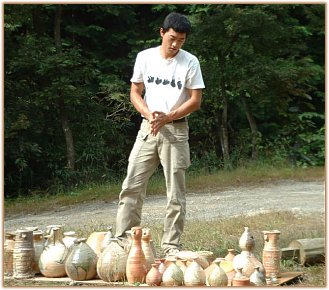
Tsujimura Kai looking over his pots
A Visit With Tsujimura Kai
Story by Aoyama Wahei
|
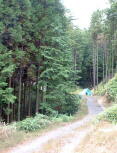
Road to Tsujimura's workshop
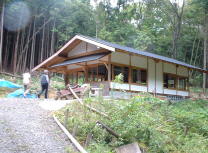
Tsujimura's workshop
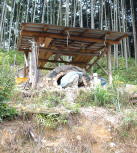
Anagama Kiln
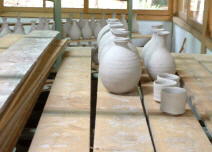
Pieces set out to dry
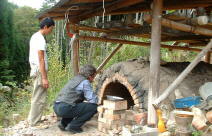
Yellin and Tsujimura
looking into kiln
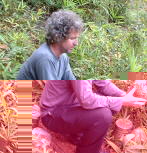
Yellin viewing piece
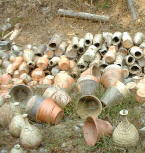
Pots scattered all about
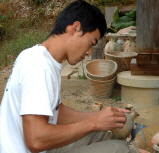
Tsujimura burnishing

Pots next to kiln
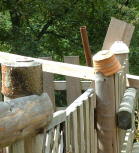
Chawan hanging from post
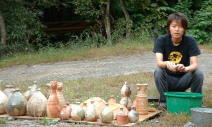
Wahei washing
|
|
Lessons in aesthetics can be taught in many ways; some are passed through oral traditions, some by actions. Yet, it may be said that the best lessons are taught through silence and love. Tsujimura Kai, the son of the world-renowned ceramist Tsujimura Shiro, has learnt the simple yet complex techniques of making beautiful pottery through such silent lessons, and it is with this passing of aesthetic sensibilities which add credence to the fact that Tsujimura Kai is not only following in his father's footsteps, but is blossoming into a skilled master in his own right.
Visiting Tsujimura Kai's kiln in the lush hills of Nara, the ancient capital of Japan, evoked both an utter freshness and a certain nostalgia. Pots were scattered throughout the hillside, placed in bushes and hidden between trees; the artwork colored the rugged landscape with their vivid shapes.
The anagama kiln was like an ancient burial mound, protruding ever so slightly from the earth. This atmosphere struck me as a scene I had yet ever experienced, as it was reminiscent of something primordial, a fantasy world of art and nature co-existing side by side, a state of nature wherein the artist was absolutely immersed in his art.
Yet it was exactly this exciting intertwining between art and life that was at the same time strangely nostalgic. Tsujimura's lifestyle called to mind ancient days where the hunter hunted in the forest he lived in, where the farmer lived off the earth he slept on. Likewise, the close connection between craft and life was visibly apparent in the young man's everyday. The wood he used for building his traditional Japanese cabin, and more importantly, uses for firing his kiln, comes from the forest surrounding his home. The earth used for his kohiki-style stoneware would be dug from the earth beneath his land. The pots he uses to eat with, the vessels he uses to drink from, were formed and fired by his own two hands. With Tsujimura Kai, his art and life are one.
And such, perhaps, is one essential tradition flowing through the blood of the Tsujimura family. Kai's father Shiro is well known for his free-will spirit. In Japan, it is not only common, but considered essential, for a ceramist to apprentice under a master potter for at least 10 years until one can have his own kiln. Such is tradition. Yet Shiro is master-less; having never been a disciple himself, he is self-taught. In other words, he is his own master. And with this unique education, Shiro climbed the mountains of the Japanese art world as both a protector and resurrector of Japanese ceramic traditions. Tsujimura Shiro also strews the grounds of his forest home with his pots, he is as close to nature as he is with his art, there is a breeziness in his walk and demeanor that evokes images of freedom from the fettering shackles of modernity. He is not a common ceramist, yet many of his work are contemporary masterpieces made in traditional Iga and Shigaraki styles of the Momoyama period.
Born in Nara on July 8th, 1976, Kai grew up watching his father breathe new life into malleable earth. "When I was young, about 4 years old, my father asked my brother and I to help him mix clay. This was the only direct lesson he had ever taught me regarding yakimono," said Kai as we sipped rice wine from his delicate kohiki guinomi. Yet as I held Kai's wonderful sake vessel in the palm of my hand, I felt the weight of his father's artistic ideals captured inside it.
Tsujimura Shiro never prompted Kai to become a potter. Shiro never taught Kai a single technique through verbal advice. Yet Kai's work follows in his father's forms because Kai ate the same meals, drank from the same cup, and slept under the same roof. Like the air we breathe, yakimono was not only natural to Kai since birth: it was everywhere. He was constantly surrounded by the towering, dynamic masterpieces of his father; it was the very essence of life since day one. Kai takes from his father through silent yet active eyes. After graduating from high school, Kai explained to me that, "it was just by the natural flow of things that I started making yakimono. When I came to my senses, I found that I was making yakimono." Kai, then 18 years of age, had made a green natural-glazed Iga-style guinomi, much in the same style as his father. He showed me this tiny treasure, now enshrined in a pleasant cotton pouch cut and stitched by Kai's wife. In the guinomi, I sensed his father's warmth.
Unlike his father, Kai does indeed have a master: his father, albeit an indirect one. The beautiful balance and maturity of Kai's forms sheds light on the thoughtful faithfulness he attaches in staying true to tradition. Such maturity is far beyond his years. It is testament to his talent as a potter; it is also testament to the fact that Tsujimura Shiro's influence lies within Kai's consciousness.
Yet it is important to remember that Tsujimura Kai's aesthetic sensibilities have been cultivated, not coached, by Shiro. In silence, his father would shape wet clay into traditional Iga and Shigaraki forms of large jars and vases, by peering above his father's shoulders the child stole the techniques of applying ash glaze to the necks of tokkuri, or sake pouring vessels. It is Kai's sharp sense of beauty, as well as his natural skills within his fingertips, which allows Kai to become an exciting ceramist. Talent, in many ways, cannot be taught.
And along with silent observation, I sensed lessons learnt through loving embrace. As I drank sake and ate a hearty meal of Japanese with the entire Tsujimura family at the father's home, I felt the enormous presence of a tradition passed through love: a love of pottery, a love of family, and a love for one's inner beliefs. Shiro posted to the pillars of his home numerous pictures of his children: pictures showing them on his knee, playing outdoors, warm smiles to melt winter snow. And such an upbringing is reflected in each and every piece of Kai's work. The battle-scarred warriors that are his Shigaraki vases, for example, have both a style and form that cannot be passed through word alone. Kai is a potter because it is a form of expression that had been by his side since he could remember. The elements that make yakimono: fire, water, wood and earth, run in his veins and are controlled by his strong, skilled hands.
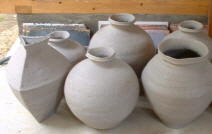 It is also his calm yet distinct vitality of youth that excites me. Rather than using his father's kiln to fire his work, at 24 Kai moved to his present day land in a different hilltop than his father, building the kiln and the house single-handedly. "It's not like I can do something different or special because I am young. In the world of yakimono, many people look upon artists as growing better with age. Yet I do not think that this is necessarily the case. There is no guarantee that I will be making work at a higher level than I am making right now. I may get worse; I may get better. But there are things I can only make now." And thus, he made his own kiln. He was eager to become independent. I believe this shows his strong will to step out from the shadows of his father, to clearly define the fact that Kai's master is none other than himself. It shows. It is also his calm yet distinct vitality of youth that excites me. Rather than using his father's kiln to fire his work, at 24 Kai moved to his present day land in a different hilltop than his father, building the kiln and the house single-handedly. "It's not like I can do something different or special because I am young. In the world of yakimono, many people look upon artists as growing better with age. Yet I do not think that this is necessarily the case. There is no guarantee that I will be making work at a higher level than I am making right now. I may get worse; I may get better. But there are things I can only make now." And thus, he made his own kiln. He was eager to become independent. I believe this shows his strong will to step out from the shadows of his father, to clearly define the fact that Kai's master is none other than himself. It shows.
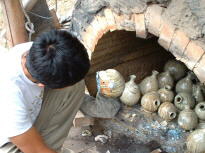 As we stood in front of his kiln (it is smaller than most anagama, a Tsujimura technique to better manipulate the kiln and to fire works more often), Kai began to unload his creations from the mouth of the dragon. The fading heat could be still felt from the kiln, the remnants of a fire so hot that it melts ashes into a landscape of color upon the skin of the pots. "Of course, I can fire my yakimono using red pine, but to me it is just a waste of time, money, and strength." A potter using red pine cannot fire alone, for he needs a helping hand to constantly load the wood into the kiln. Kai's firm, independent spirit as a potter can be seen in the fact that he staunchly refuses to fire in such a way. To make yakimono by one's own self is very important to this ceramist, and this is a distinguishing feature of Tsujimura Kai that sets him apart from ceramists his age. Once again, he is his own master. As we stood in front of his kiln (it is smaller than most anagama, a Tsujimura technique to better manipulate the kiln and to fire works more often), Kai began to unload his creations from the mouth of the dragon. The fading heat could be still felt from the kiln, the remnants of a fire so hot that it melts ashes into a landscape of color upon the skin of the pots. "Of course, I can fire my yakimono using red pine, but to me it is just a waste of time, money, and strength." A potter using red pine cannot fire alone, for he needs a helping hand to constantly load the wood into the kiln. Kai's firm, independent spirit as a potter can be seen in the fact that he staunchly refuses to fire in such a way. To make yakimono by one's own self is very important to this ceramist, and this is a distinguishing feature of Tsujimura Kai that sets him apart from ceramists his age. Once again, he is his own master.
"I think it is only inevitable that people will compare me to my father. Yet this really doesn't bother me. I create Shigaraki and Iga yakishime wares as well as Karatsu and Kohibi much in the same spirit as my father because I believe they are truly good styles as well as good forms. Good things need not be changed."
It is with great enthusiasm that we introduce to you the world debut of a wonderful young artist. It is without a doubt that Tsujimura Kai will one day stand shoulder to shoulder with his father. Please take the time to view and enjoy his work before they become an insatiable dream.
LEARN MORE
|
|
|
|
|
|